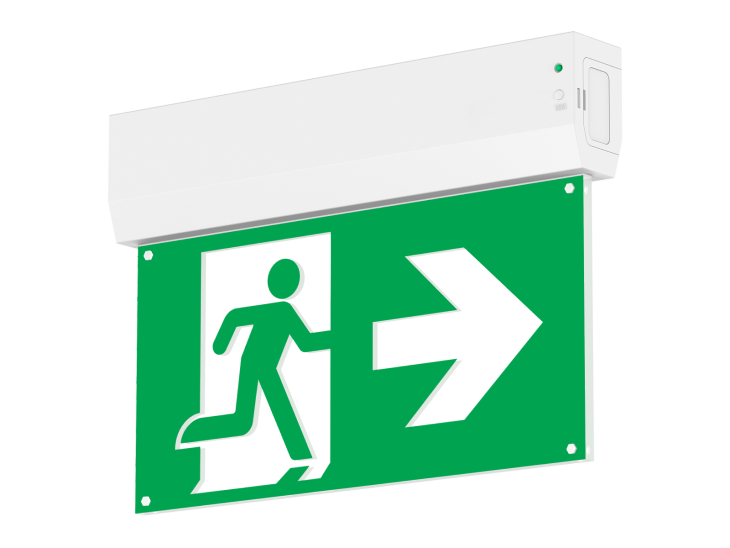Maintained vs Non-Maintained Emergency Lights for Businesses
Relative power usage of Maintained vs Non-Maintained emergency lighting
How does the amount of energy used by maintained (always on) and non-maintained (only on when mains power fails) emergency lights compare?
Maintained lights are always on, and as such naturally use more power. However, even non-maintained lights do require a constant trickle charge from the mains power to maintain the backup battery. Over their lifespan, non-maintained emergency lights will still consume less energy, though.
Let's use a traditional emergency bulkhead with fluorescent tube as a reference point. A maintained version consumes 21 watts of energy per hour, whereas the non-maintained version uses only 8W per hour. This clearly shows that maintained lighting uses a good deal more power when compared to non-maintained options.
Can I save power by switching to non-maintained emergency lighting?
Whilst the answer here is undeniably yes, the decision about which type of emergency lighting is installed cannot be made on financial or environmental grounds alone. The general rule of thumb is that non-maintained emergency lighting is acceptable in situations where the occupants of the building can be expected to be familiar with their surroundings. This covers most workplaces such as offices as the occupants know their surroundings well.
If you are selecting an emergency light for an area that is open to the public, then maintained emergency lighting is the norm. This ensures that exit points and escape routes are fully lit at all times, which helps in evacuation situations where there is no power failure.
Of course, whether maintained or non-maintained, the most crucial function of an emergency light is to provide sufficient lighting when the mains supply is interrupted. When this happens, the luminaire changes into emergency lighting mode and draws power from its backup battery to continue functioning.
Why does my emergency light dim when the light goes into emergency mode?
Light output for emergency luminaires is measured in Lumens. Lumens is the standard unit of measurement for the amount of light emitted from any given light.
In general terms, a higher lumen rating means greater visibility in the vicinity of the light fitting. Maintained emergency lights have a set lumen level when in standard operation, but often a lower lumen level when in emergency mode. If we return to a standard fluorescent emergency bulkhead light as an example, the lighting level drops from 320 lumen in standard maintained operation, to 80 lumens when in emergency mode. This allows the emergency light to last longer while still maintaining a sufficient level of lighting meeting the recommendations within BS EN 1838:2013 - Lighting applications. When selecting an emergency light fitting for your premises, it is crucial to consider the amount of light required in emergency mode when designing a system.
Are LED emergency lights a good choice?
The advent of emergency light fittings manufactured with light emitting diodes (LEDs) rather than conventional fluorescent tubes has brought about a big power saving opportunity for businesses.
Maintained emergency luminaires with LED lights use only a fraction of the power consumed by light fittings with standard tubes. In the case of bulkheads the consumption drops to below 5W. Traditional fluorescent tubes must also be replaced periodically. If a bulb shows signs of wear such as a greying at the ends of the tube, they should be replaced immediately. By contrast, the LEDs supplied as part of LED emergency lighting should last for the entire lifespan of the device, presenting a secondary and considerable cost saving.
LED emergency lights are a far superior choice for maintained emergency lighting, due to the significant difference in the amount of energy they consume and the cutting out of maintenance costs for lighting tubes.
Why is the warranty period for maintained emergency lighting often shorter?
It can seem strange that the warranty period on some emergency lighting products differs depending on whether it’s a maintained or non-maintained unit, but this is simply a consequence of the relative load placed on an emergency light fitting during its lifespan. Non-maintained lights are only expected to be in use in an emergency or during the periodic tests of the lights. This means that the internal workings of the light are effectively used less, and therefore they can be expected to last longer. A common warranty period for maintained emergency lighting is three years, which is still a substantial minimum lifespan. However, Safelincs offers longer warranty periods (five years) even for maintained emergency lights.
It is worth noting that items termed as 'consumables' (for example tubes and replaceable backup batteries) are not covered by most extended warranties, as it is expected that these may need to be replaced from time to time.
Which type of emergency light is the best choice for my business?
Whilst there is no catch-all answer, as individual circumstances may require special consideration, in general terms LED emergency lights are the most energy and cost efficient option. This is especially true when maintained emergency lighting has to be used, but will hold true in most circumstances.





